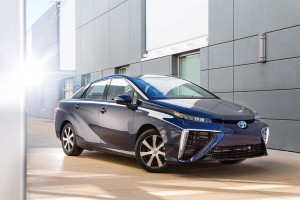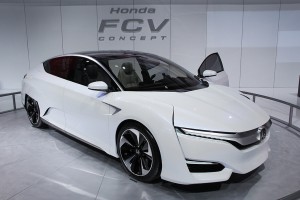
Toyota Mirai, the maker's hydrogen fuel cell car, represents its future rather than electric vehicles.
As part of its broader shift away from nuclear power, Japan is turning towards hydrogen, a lightweight gas some proponents like to call the fuel of the future.
The government has approved an investment of 45.2 billion yen, or $385 million, to set up a network of hydrogen refueling stations that will be in place in time for the 2020 Olympics in the capital city of Tokyo. The money also will provide subsidies for the development of hydrogen fuel-cell vehicles.
“It’s time to introduce a hydrogen era,” Prime Minister Shinzo Abe told reporters after test driving the new Toyota Mirai.
Just going into production, the debut of the Mirai marks the first time the maker has offered a fuel-cell vehicle, or FCV, to the public. Toyota officials are turning to hydrogen because, they contend, it offers a number of key advantages over the other zero-emissions technology, battery power. A tank of the lightweight gas can power a Mirai up to 300 miles, and refueling takes less than five minutes – compared to 100 miles range and many hours to recharge with most battery cars.

After a being delayed due to the Takata airbag problem, FCV production will start next year. Photo credit: Len Katz
Other manufacturers are using similar arguments as they also push into hydrogen power. Honda revealed the final, production-ready version of its new FCV fuel-cell vehicle at the Detroit auto show last week. It will go on sale in 2016. Korean carmaker Hyundai launched a fuel-cell-powered version of its Tucson SUV in 2014. And other makers, including General Motors and Mercedes-Benz are considering production FCVs, as well.
The big challenge is the lack of a hydrogen infrastructure. The Hyundai, Toyota and Honda vehicles will all be sold in Southern California, where there is a small network of refueling stations. But traveling much out of the region would be difficult until California moves forward on a plan to establish a statewide network of pumps open to the public.
The state is providing a large investment to support that plan, but Toyota and Honda have both announced corporate involvement in commercial hydrogen refueling ventures in the U.S.
Bob Carter, Toyota’s vice president of automotive operations in the U.S. told TheDetroitBureau.com the maker hopes that by building up an infrastructure more buyers will shift to hydrogen. In turn, as sales of hydrogen cars grow that should spur the energy industry to pump money of its own into setting up new filling stations.
Toyota has confirmed it will also participate in infrastructure development in Japan, as well.
(Toyota takes top sales spot in 2014. For more, Click Here.)
But the big push is likely to come, at least initially, from the Japanese government. The stated goal is to have 6,000 hydrogen cars on the road in time for the 2020 Olympics, along with 35 refueling stations around Tokyo, according to Makoto Fujimoto, head of planning at the city’s energy department.
As much as 80% of the cost of those service stations will be covered by the government, noted a report by the Bloomberg news service. Purchases of fuel-cell vehicles also will be subsidized by the government.
(Click Here for details about Toyota’s tease of its new RND concept.)
About 60% of the orders Toyota has so far received for the Mirai have come from government and corporate fleets in Japan. The maker had originally expected just 400 orders for the entire year. That led Toyota President Akio Toyoda to last week to tell reporters the company may bump up production for the fuel-cell vehicle.
Not everyone is convinced hydrogen power is the way to go. Elon Musk, the CEO of one-time Toyota ally Tesla Motors, has denounced fuel-cell technology as an alternative to battery power. Others note that while hydrogen is the most abundant element in the universe it is not freely available on Planet Earth. Instead, it must be released from some other compound, whether by cracking a fossil fuel such as petroleum, natural gas or coal, or by electrolyzing water.
(To see more about Toyota’s plans to “stay the course” toward 54.5 mpg CAFE standard, Click Here.)
But splitting water into its components – hydrogen and oxygen – requires significant energy that could prove a problem for a country moving away from its post-War dependence on electricity generated from nuclear power. How Japan intends to expand its supply of hydrogen remains to be seen.

I do believe that hydrogen FCV vehicles are the future for many if the safety issues have been properly addressed. It’s a no brainer for the oil industry Cabal to add hydrogen at their company owned stations as it’s not that expensive an investment and they get to write it all off. The auto makers need to work with the gas stations as it’s a win-win for all involved.
EV’s are still not viable for most people and they unlikely to ever be even with improved battery tech. A battery is a useful device for many things but the energy storage capacity is just too low in comparison to crude oil products and hydrogen.
BTW, Elon electricity is not free and most of it is generated by coal, nuclear or wind. The toxic batteries used in EVs are a serious danger from the beginning of their life until the very end, especially if they are damaged in any way, which usually results in a fire as Tesla is quite aware.
Recharging stations for those EV owners who would like to travel longer distances are simply not going to cut it. That means battery swaps are required and without universal battery models the companies that have tried this have failed at the battery swap test.